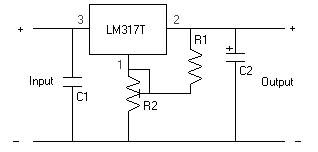The car cigarette lighter socket does not only light cigarettes, but can be utilized as an electrical channel for powering tools to work on the car such as laptops and other electronic devices. The following circuit diagram shows a way of powering a two-way mobile radio using the LM317T voltage regulator.
The LM317T is an adjustable 3-terminal positive voltage regulator that efficiently provides a load current of 1.5 Amps over an output range of 1.2 V and 37 V. With reference to the circuit, it can accept 14 volts without any hassle and the voltage can be controlled easily with the use of a potentiometer, a 3-terminal resister with sliding contact. The whole circuit will contain the following components:
The LM317T is an adjustable 3-terminal positive voltage regulator that efficiently provides a load current of 1.5 Amps over an output range of 1.2 V and 37 V. With reference to the circuit, it can accept 14 volts without any hassle and the voltage can be controlled easily with the use of a potentiometer, a 3-terminal resister with sliding contact. The whole circuit will contain the following components:

Printed Circuit Board (PCB)
Resistor 1 (R1): 270 ohms
Resistor 2 (R2): 2K carbon potentiometer
Capacitor 1 (C1): 100nF
Capacitor 2 (C2): 1uF tantalum
LM317T Voltage Regulator
Heat Sink
DC Power Jacks
Green LED: Power
Red LED: Over Voltage
Zener Diode: over voltage LED switch
The zener diode switches on the over voltage LED if the voltage passing through is larger than the breakdown or preset voltage. The use of zener diode permits a constant amount of voltage and can be very beneficial for devices that inputs the same amount of voltage.
LM317T is cheaply available in the market and is very simple to integrate into several energy system to supply a maximum current or voltage.
Resistor 1 (R1): 270 ohms
Resistor 2 (R2): 2K carbon potentiometer
Capacitor 1 (C1): 100nF
Capacitor 2 (C2): 1uF tantalum
LM317T Voltage Regulator
Heat Sink
DC Power Jacks
Green LED: Power
Red LED: Over Voltage
Zener Diode: over voltage LED switch
The zener diode switches on the over voltage LED if the voltage passing through is larger than the breakdown or preset voltage. The use of zener diode permits a constant amount of voltage and can be very beneficial for devices that inputs the same amount of voltage.
LM317T is cheaply available in the market and is very simple to integrate into several energy system to supply a maximum current or voltage.
Comments
Post a Comment